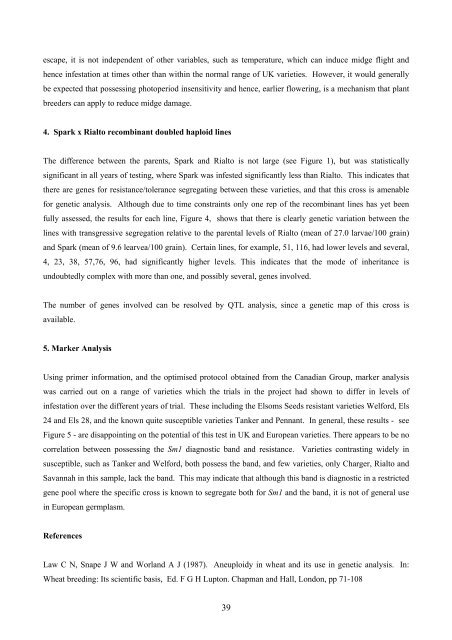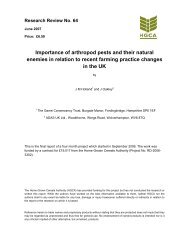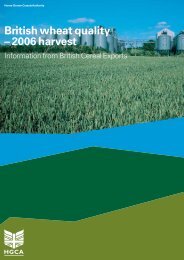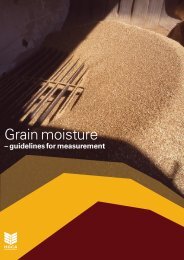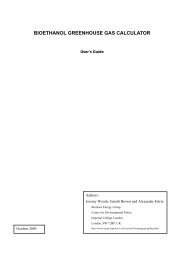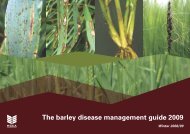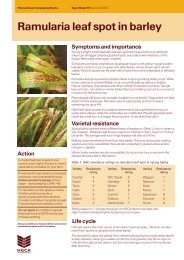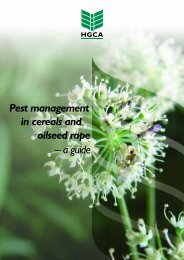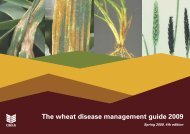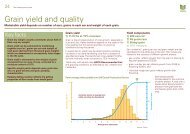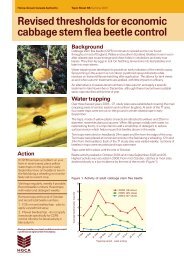Integrated control of wheat blossom midge - HGCA
Integrated control of wheat blossom midge - HGCA
Integrated control of wheat blossom midge - HGCA
You also want an ePaper? Increase the reach of your titles
YUMPU automatically turns print PDFs into web optimized ePapers that Google loves.
escape, it is not independent <strong>of</strong> other variables, such as temperature, which can induce <strong>midge</strong> flight andhence infestation at times other than within the normal range <strong>of</strong> UK varieties. However, it would generallybe expected that possessing photoperiod insensitivity and hence, earlier flowering, is a mechanism that plantbreeders can apply to reduce <strong>midge</strong> damage.4. Spark x Rialto recombinant doubled haploid linesThe difference between the parents, Spark and Rialto is not large (see Figure 1), but was statisticallysignificant in all years <strong>of</strong> testing, where Spark was infested significantly less than Rialto. This indicates thatthere are genes for resistance/tolerance segregating between these varieties, and that this cross is amenablefor genetic analysis. Although due to time constraints only one rep <strong>of</strong> the recombinant lines has yet beenfully assessed, the results for each line, Figure 4, shows that there is clearly genetic variation between thelines with transgressive segregation relative to the parental levels <strong>of</strong> Rialto (mean <strong>of</strong> 27.0 larvae/100 grain)and Spark (mean <strong>of</strong> 9.6 learvea/100 grain). Certain lines, for example, 51, 116, had lower levels and several,4, 23, 38, 57,76, 96, had significantly higher levels. This indicates that the mode <strong>of</strong> inheritance isundoubtedly complex with more than one, and possibly several, genes involved.The number <strong>of</strong> genes involved can be resolved by QTL analysis, since a genetic map <strong>of</strong> this cross isavailable.5. Marker AnalysisUsing primer information, and the optimised protocol obtained from the Canadian Group, marker analysiswas carried out on a range <strong>of</strong> varieties which the trials in the project had shown to differ in levels <strong>of</strong>infestation over the different years <strong>of</strong> trial. These including the Elsoms Seeds resistant varieties Welford, Els24 and Els 28, and the known quite susceptible varieties Tanker and Pennant. In general, these results - seeFigure 5 - are disappointing on the potential <strong>of</strong> this test in UK and European varieties. There appears to be nocorrelation between possessing the Sm1 diagnostic band and resistance. Varieties contrasting widely insusceptible, such as Tanker and Welford, both possess the band, and few varieties, only Charger, Rialto andSavannah in this sample, lack the band. This may indicate that although this band is diagnostic in a restrictedgene pool where the specific cross is known to segregate both for Sm1 and the band, it is not <strong>of</strong> general usein European germplasm.ReferencesLaw C N, Snape J W and Worland A J (1987). Aneuploidy in <strong>wheat</strong> and its use in genetic analysis. In:Wheat breeding: Its scientific basis, Ed. F G H Lupton. Chapman and Hall, London, pp 71-10839


